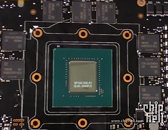Friday, April 22nd 2016

NVIDIA GP104 "Pascal" ASIC Pictured
Here are two of the first pictures of NVIDIA's upcoming "GP104" graphics processor. This chip will drive at least three new GeForce SKUs bound for a June 2016 launch; and succeeds the GM204 silicon, which drives the current-gen GTX 980 and GTX 970. Based on the "Pascal" architecture, the GPU will be built on TSMC's latest 16 nm FinFET+ node. The chip appears to feature a 256-bit wide GDDR5 memory interface, and is rumored to feature a memory clock of 8 Gbps, yielding a memory bandwidth of 256 GB/s.
Sources:
ChipHell, AnandTech Forums


56 Comments on NVIDIA GP104 "Pascal" ASIC Pictured
GP104 will be the new mid range GPU from Nvidia, and will roughly perform on the level of today's high end. So for anyone currently owning a GTX 980 Ti this wouldn't be much of an upgrade.
I'm looking forward to the new high-end model (probably a new Titan first), which should arrive in late Q3 or Q4. There is a GP102 chip in the works so this could be it. Even if it turns out that it uses GDDR5X I will be satisfied as long as they fill it with many Cuda cores.
There is too much hate regarding HBM because people simply compare Fury X to 980Ti and discredit all the major benefits of HBM. Fury X's front-end bottlenecks, lack of sufficient ROPs, weak geometry engines and lower clock speeds exacerbated by lack of decent overclocking headroom, pump whine, etc. all contributed to its lackluster performance and standing against after-market 980Ti cards. If we were to isolate HBM and compare it head-to-head against GDDR5X, it's a far superior alternative, if costs permit its use.
Considering how NV was able to perform very well this generation with 256-bit/384-bit bus cards and not even rely on HBM, but now we know that GP100 uses HBM2, I am going to agree with AMD and NV engineers that if costs are not a factor, then HBM2 big Pascal and Vega are far superior options. Since NV already has GP100 with HBM2 and AMD has Vega with HBM2 on the road-map, it's pointless to debate a hypothetical 384-bit big Pascal or Vega.
And now that we have GDDR5X which is currently much cheaper than HBM, and GDDR5X on a 384-bit bus will 576 GB/s, it will still be a while before gaming GPUs really need HBM.
BTW, Fiji is not struggling from ROP performance, that kind of problem would increase with resolution or AA. It does however have enormous inefficiencies in it's scheduling, in the 30-50% range compared to Maxwell.HBM will replace GDDR5(X) over time. GP100 uses HBM2 because it needs the bandwidth for compute. HBM2 will still be limited in supply throuout 2016. We'll see in a few months what GP102 has in store for us, it wouldn't surprise me if it uses GDDR5X, which would be fast enough until HBM becomes cheaper.
My hunch is, given that both AMD and Nvidia have now access to 14/16nm processes (which are a great leap from 28nm), their new architectures will play a much greater role than simply comparing shader count and bandwidth.
Titan X cannot access all his 12GB in one cycle actually, thus making some hurdles in particular usage scenarios like rendering and and heavy data processing with lot of calculated data. For high resolutions 4-5K it will be crucial to have really wide bus, the more power it has, the more space and less latency it needs.
HBM is actually developed for server and compute needs, the gaming market comes second.
wccftech.com/amd-stock-52-highest-percentage-gain-listing/
As for the stock jump - no biggie - AMD announces x,y and z and investors buy because people buy cheap stocks to gamble they will make money. It's speculative investment - most will sell just before the launch of Polaris and Zen. Also helps to announce a prospective mega bucks deal with China - makes it all look better.
Not saying these things are not good or happening but as a bit of an anti capitalist (specifically in the proliferation of huge private wealth, gained at the expense of others, with zero social distribution) I fucking hate the stock markets - they're bogus.